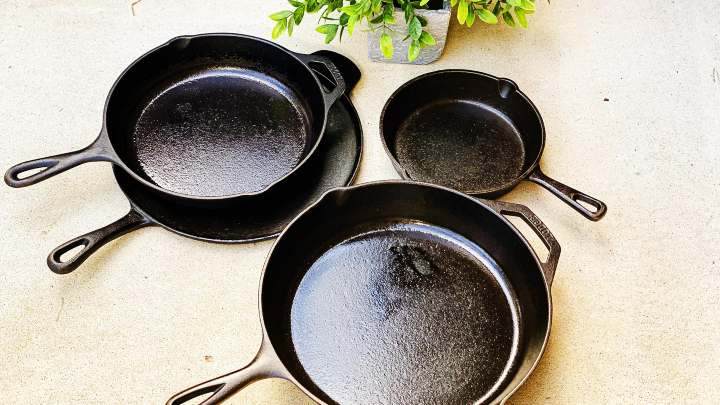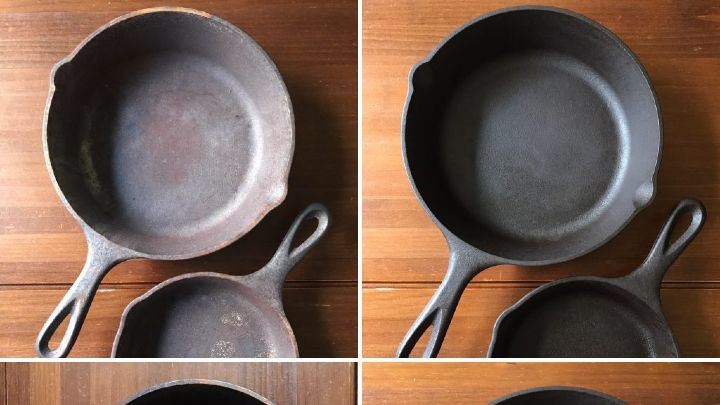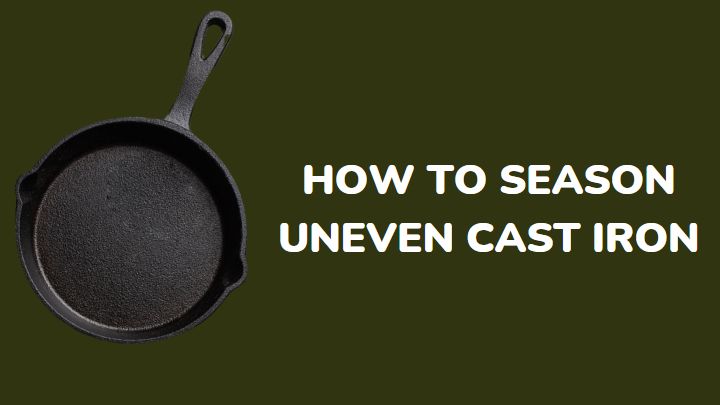Uneven cast iron seasoning can make cooking a little tiring. It makes the pan rough, patchy, greasy, and sticky. Cooking is never a good experience with this.
Knowing how to season your cast iron will help you deal with the almost inevitable dullness and patches that tend to appear under your pan. It will also save you from ending up with a burnt dish.
If you’re unsure how to fix uneven seasoning in cast iron, read this article to get detailed instructions. Also, the article lists factors that cause uneven cast iron and the various types of lubricants that make cast iron seasoning easy.
What is cast iron seasoning?

Cast iron seasoning is an oily coating that is baked onto the iron pan’s surface. The oil goes through a polymerization reaction at high temperatures that turn it into a solid and binds it to the iron.
A well-seasoned cookware has a shiny black patina. In addition to preventing rust and food from sticking to the pan while cooking, it creates a natural, simple cooking surface.
What does uneven seasoning in cast iron look like?
Uneven seasoning in cast iron gives the pan a patchy appearance. While some areas might look gray and dull, the other parts might look shiny and black.
Instead of an even smoothness and uniformity, you will also notice that some areas feel rough, sticky, or raised.
How to fix uneven seasoning in cast iron
Follow these steps to evenly season a cast iron pan:
Pan washing and drying
The pan should be thoroughly cleaned in warm, soapy water. Then, dry it thoroughly. After towel drying, there may be some surface moisture, so it is best to place the pan over a stovetop flame for a few mins to dry up any remaining water.
Apply oil all over the pan and buff well
After cleaning and drying your pan, rub cooking oil all over the pan or skillet. Do not oil the handle.
The secret is to scrub the pan well with a soft cloth or paper towel after applying the oil so it does not appear greasy.
A little extra oil on the pan can slip through the seasoning, forming sticky drops on your cooking surface if left unattended for a few days.
Heat the pan in the oven
Put the oiled pan in a 450°F oven and bake for 30 minutes. Keep your kitchen well-ventilated because it will get smokey.
After 15 minutes, the oil polymerizes and forms the first of several hard, silicone-like coatings. If the pan is still oily, bake it a little longer.
Repeat process again
When the half-hour is up, take the pan outside to cool. Once it has cooled, buff it before rubbing oil on it. Then, re-bake in the oven for 30 more minutes.
You should repeat this heating and frying process three to four times to get a firm base for your seasoning. If the seasoning did not stick well, re-bake at a higher temperature.
What should a seasoned cast iron look like?

A properly seasoned cast iron pan should have a standard deep shiny black color without blotches or gray spots.
Additionally, it must be smooth to the touch and not gritty, greasy, or sticky. If the water quickly beads up and runs off the surface, your skillet is well-seasoned and good to use.
Bare cast iron that has not been seasoned has a silver color. Seasoning turns it into a black hue.
How many times should you season cast iron?
A cast iron pan should be seasoned about three times consecutively before use, evenly seasoned or not. You may not always have to go through the entire process, but you should at least season it with oil after each use.
Based on usage patterns and frequency, a well-seasoned pan should be seasoned 2 to 3 times annually.
The best oils for seasoning cast iron
Oils with high unsaturated fat and low saturated fat content are the best options for seasoning cast iron. You should also confirm that your oven can maintain a temp up to 25 to 50°F higher than the oil’s smoke point for 60 minutes.
The following oils are most suitable for cast iron seasoning:
1. Flaxseed oil
Flaxseed oil is a superb option for constructing a very robust and long-lasting seasoning layer because it has a low percentage of trans fat. It also has a very low smoke point and doesn’t require high heat in the oven.
2. Grapeseed oil
Grapeseed oil’s fat profile is quite comparable to that of flaxseed oil. This makes it another great option for creating a thick, even seasoning layer. It is readily available and less expensive than flaxseed oil.
3. Canola oil
Based on its fat profile, canola oil might seem like a good choice, but it’s important to note that most low-quality canola contains contaminants that can make cast iron sticky or streak.
Therefore, you should use high-quality oil made entirely of canola oil and contains no additives or propellants.
How to prevent uneven seasoning on cast iron
If your cast iron is uneven after seasoning, you might have skipped some steps. You should, therefore, learn how to stop iron from becoming uneven. Here is how to:
Use flaxseed oil
Using vegetable or olive oil is one of the common errors in seasoning uneven cast iron. This is not the worst choice, but it is not the best either.
The best oil for seasoning is flaxseed oil because it has a low smoking point, high levels of unsaturated fats, and high levels of omega-3 fatty acids- all of which aid in the polymerization of seasoning.
Warm up your cast-iron pan
One of the mistakes many people make when seasoning cast iron is that they forget to preheat the pan.
Although it does not impact the seasoning process, it can result in an uneven cast iron seasoning.
In comparison to other materials used to make pans, cast iron heats slowly and evenly. Therefore, warm up each cast iron pan separately so the oil can heat up evenly and season evenly.
Apply a thin coating of oil
It may be tempting to coat the entire pan with a lot of olive oil, but it doesn’t work like that. Too much oil prevents polymerization which consequently results in uneven seasoning.
Flip the pan and bake upside down
People often forget to turn their pans upside down in the oven, possibly because it does they do not know.
If you don’t flip the pan over, the extra coating of oil will build up unevenly and haphazardly coat the pan. I’m sure you don’t want extra food sticking to your pan, and you don’t want your cast iron to become unevenly seasoned.
Baking the pan upside down will cause the excess oil to drip off, leaving a perfect even coating all over the pan.
Coat the bottom of the pan with some foil too. This helps to prevent excess dripping and makes it easier to clean the shelves below.
Season your cast-iron frying pan multiple times
You must season your large iron more than once and frequently to prevent uneven wear.
FAQs
Why does your cast iron look bronze after seasoning?
Freshly seasoned cast iron may have a brownish bronze hue. It’s just the initial patina baking in; it’s not rust.
It may require several uses and seasoning coats to achieve a black finish. Use the pan anyway, do not be concerned about the brownish hue.
What happens if you over-season cast iron?
It may seem strange, but it is possible to season a cast iron pan excessively. When this happens, too much oil will polymerize in patches and eventually begin to peel off the surface of the cast iron.
Why is your cast iron sticky after seasoning?
If your seasoning is overly sticky and won’t wash off with water and soap, you probably didn’t bake the pan upturned in the oven long enough, and this prevented a small amount of oil from polymerizing.
The secret to keeping cast iron from becoming sticky in the oven is to bake your pan inverted and be patient. Give the seasoning enough time to bake and extra time for the oil to seep off.
Conclusion
Cast iron with uneven seasoning is annoying, and despite your best efforts, the finish is still uneven.
Even though re-seasoning your cast iron can be tiresome, it is not a difficult task. Nonetheless, be sure to follow the seasoning instructions precisely to prevent an uneven iron.
Don’t stop here. Become a better cook at home with these helpful cooking tips.
Thanks for reading.

